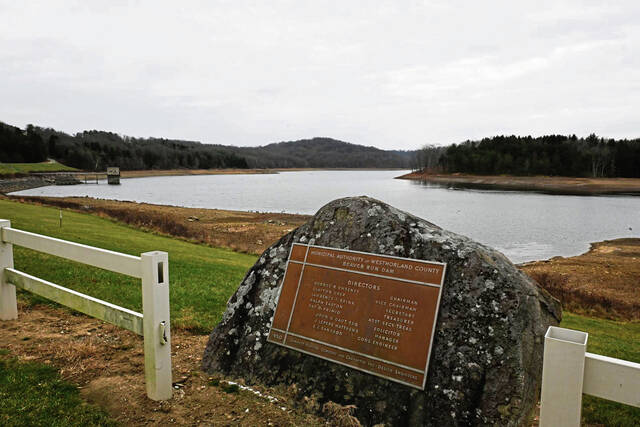Rain fails to ease concerns over falling water level at Beaver Run Reservoir
Heavy rains over the past two weeks have had little impact on water levels at the Municipal Authority of Westmoreland County’s Beaver Run Reservoir.
Officials in mid-November issued a mandatory call for water conservation for nearly half of the agency’s water customers amid drought-like conditions near the reservoir in Bell and Washington townships.
Heavy rains during the Thanksgiving holiday weekend weren’t enough to make an impact on the reservoir, said MAWC Manager Michael Kukura.
“It’s just not filling up,” Kukura said, noting that recent rains have yet to counteract water taken out of the reservoir each day to service the northern half of the authority’s customer base, even as cuts were made to stem the flow of water.
According to the National Weather Service in Moon, the area near the reservoir received about 1.7 inches of rainfall from Nov. 17 through the middle of last week.
The state Department of Environmental Protection on Friday added Westmoreland County to a list of 14 counties on the Commonwealth Drought Task Force watch list.
A lack of rain and snow over the past year has left officials scrambling to deal with declining water levels at the reservoir, which is the primary source of drinking water for about 53,000 Municipal Authority of Westmoreland County customers who live north of Route 30.
Authority officials said the area around the reservoir has had a more than 11-inch rainfall deficit over the past year.
The reservoir, when full, can hold up to 11.4 billion gallons. It contained 5.6 billion gallons Nov. 27 and was more than 2 billion gallons shy of annual averages for November, according to the authority.
Late-November rains added 256 million gallons since Nov. 17, but levels have not rebounded.
Should the region’s dry spell continue, another 12-inch drop of the water level would trigger a mandatory call for conservation, Kukura said.
Additional rainfall can help delay mandatory cuts, should they be necessary in the coming weeks.
Those cuts would impact commercial uses such as car washes and golf courses. Kukura said residential customers won’t see much of an impact of mandatory conservation efforts during the winter months.
“We’ve made a lot of moves and (halted) fracking (at the reservoir site), but we’re praying for rain,” Kukura said.
Jared Rackley, a meteorologist at the National Weather Service, said northern Westmoreland County is expected to see average rainfall through February.
The authority previously withdrew about 21 million gallons a day from Beaver Run Reservoir. Over the past two weeks, it has decreased its intake to 17 million gallons.
It diverted water from the Youghiogheny River, near Connellsville, which supplies the authority’s southern service area, to ease the burden on the reservoir.
Officials said the voluntary call for customers to reduce water usage by not washing vehicles or watering lawns and avoiding other discretionary purposes is not expected to lead to quick improvements.
More precipitation is the best solution, according state officials.
“There is not a general rule of thumb for determining when a drought is over,” said Josslyn Howard, spokeswoman for the Department of Environmental Protection. “Droughts can have varying effects, depending upon their timing, severity, duration and location and can be very localized depending upon precipitation patterns.
“Recovery from drought will depend on the extent and severity of the dry conditions and then the timing, duration and intensity of the precipitation, among other factors.”
Rich Cholodofsky is a TribLive reporter covering Westmoreland County government, politics and courts. He can be reached at rcholodofsky@triblive.com.
Remove the ads from your TribLIVE reading experience but still support the journalists who create the content with TribLIVE Ad-Free.

